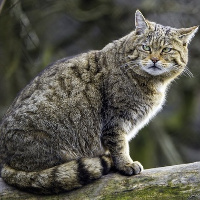 |
Forest cat |
|
He is a wild animal |
Origin |
Europe | |
Translation |
Francis Vandersteen |
| The possession of this animal is not authorized Royal Decree establishing the list of mammals not kept for production purposes that may be kept (M.B. 24.08.2009) |
| Although they may look like our domesticated companions, forest cats (also known as wildcats) are a species in their own right, living, as their name suggests, in and around forested areas. It consumes small mammals and other prey, which it hunts mainly in open areas near forest edges. The problem of hybridization with the domestic cat (and in particular with domestic individuals that have returned to the wild, known as "harets" or "strays") poses a significant problem for the conservation of the forest species. A study on the introgression of domestic genes in forest cats is currently underway at the University of Liège. The forest cat is slightly larger than the domestic cat, measuring between 73 cm and 1 m in length (including tail), with an average weight of around 4 to 5 kg in the male and between 3.5 and 4 kg in the female. However, individual body weights can vary considerably depending on the season. The forest cat's basic coat color varies from grayish fawn to light fawn. It is generally barred with black stripes, very diffuse on the flanks. These are connected to a fairly clear black dorsal line that starts between the shoulder blades and runs to the tip of the body (but not on the tail). The tail is cylindrical, with black rings (more pronounced towards the tip) and a thick black terminal tip (about 3.5 to 4 cm wide), unlike the domestic cat, where it is tapered. The forest cat's skull is wider, its hind legs more robust and its fur thicker than the domestic cat's, giving it a stockier appearance. However, since hybridization between the Forest Cat and the Domestic Cat is well documented, and not necessarily based on visible characteristics, it is impossible to tell the difference between a Forest Cat and a hybridized cat by simple observation. The forest cat's distribution in Europe is highly fragmented. These nuclei probably reflect the regression of forest massifs, especially during the period 1700-1900. The forest cat occupies the Iberian peninsula, central and eastern Europe, Italy and Sicily (the only Mediterranean island where the species is present). In Scotland, hybridization with the domestic cat seems to have been so strong that it is difficult to find pure-bred sylvan individuals (88% of individuals are said to be hybridized). The Belgian population is part of a nucleus that also includes northeastern France, Luxembourg and southwestern Germany. |






 English (United Kingdom)
English (United Kingdom)